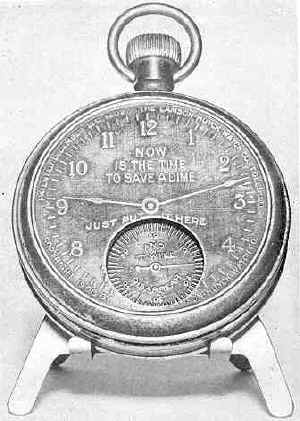Watch Bank (Dime Disappears)
by F.H. Griffith - HOBBIES Magazine - February, 1970
 An unusual mechanical bank that fits into the "object"
group is our choice as No. 178 in the numerical classification. The bank is the Watch Bank
(Dime Disappears) and it represents an object — a pocketwatch. Mechanical banks of
this nature are rather uncommon and details on certain banks that represent objects and
form a group were given in the article on the Safety Locomotive Bank (HOBBIES, September,
1960). Briefly, other mechanicals in the group are the American Bank (Sewing Machine),
Camera Bank, Pistol Bank, Safety Locomotive, and now the Watch Bank under present
discussion.
An unusual mechanical bank that fits into the "object"
group is our choice as No. 178 in the numerical classification. The bank is the Watch Bank
(Dime Disappears) and it represents an object — a pocketwatch. Mechanical banks of
this nature are rather uncommon and details on certain banks that represent objects and
form a group were given in the article on the Safety Locomotive Bank (HOBBIES, September,
1960). Briefly, other mechanicals in the group are the American Bank (Sewing Machine),
Camera Bank, Pistol Bank, Safety Locomotive, and now the Watch Bank under present
discussion.
Before proceeding further with details on the Watch Bank, a point of possible confusion must be explained. There are two different Watch Banks, both mechanical, both operate with dimes, and each are metal stampings. The other Watch Bank (to be classified in article form at a future date) was detailed in capsule form in HOBBIES, September, 1963. This one is known as the Watch Bank (Metal Stampings) and its operation is comparable to that of the Safety Locomotive. The Watch Bank (Dime Disappears) is, as we shall see, entirely different in its operation.
The Watch Bank shown is in fine original condition and is a fairly recent addition to the collection of Edwin H. Mosler, Jr. So far, to the best of the writer’s knowledge, it is the only one known to exist and comes into the category of being a new find. It had been in another party’s possession for some time, but remained so with a degree of obscurity. In coming into the possession of Mr. Mosler this situation has changed and the bank can now receive its due recognition.
The bank was patented December 21, 1909, by Francis P. Huyck and John D. Lamson of Toledo, Ohio, and manufactured by their concern, the Lamson-Huyck Watch Company, also of Toledo. The patent papers consist of a very detailed text and two pages of drawings with 12 diagrams thereon, which is quite exceptional. These drawings cover several different methods of operation of the spring mechanism. The bank as produced closely follows one of these methods. In covering the spring mechanism operation in various forms it was the obvious intent of Messrs. Huyck and Lamson that no one would be able to come up with a patent of similar nature to their bank in its unique operation.
The bank is a nickel plated metal stamping with a brass face and back. Above the hour and minute hand just under the 12 appears "Now Is the Time to Save A Dime," under the hands over the second hand section is "Just Put It Here." Stamped on the second hand dial is "And It Will Disappear." Around the face of the dial, bottom half — "Copyright 1908 By the Lamson-Huyck Watch Company," top half of face — "Patented December 21st 1909 — The Lamson-Huyck Watch Co., Toledo, O." All this detailed lettering is most unusual — it enhances the bank and it’s a real pleasure to come across a mechanical that shows the manufacturer, the patent date, and operating instructions all on the bank itself. What the writer is trying to say is when you hold this bank in your hands everything is right there; who made the bank, when it was made, and so on.
Now to the operation of the bank. It must first be taken apart and the spring mechanism is wound by hand. The spiral spring is on a circular wire that conforms to the inside circle of the case and this is revolved a number of times and then fastened in place. The case is then snapped together and the bank is ready for action. A dime when placed on the second hand dial immediately disappears. Actually the mechanism snaps the coin inside the bank so fast that it seems to disappear. Another dime placed in the same fashion disappears immediately, and it will take quite a few dimes before it is necessary to re-wind the spring. This is nice action in a bank, particularly so when it is only the size of an old fashioned pocketwatch.
In closing it bears mention that one of the patent diagrams covered a stem wound spring, but as produced the stem is not operable. It is rather apparent that the way the bank is made offered a more sturdy, less troublesome type of construction and operation.
